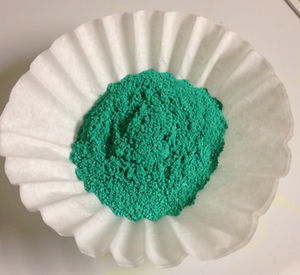Difference between revisions of "Copper(II) carbonate"
| Line 124: | Line 124: | ||
==Handling== | ==Handling== | ||
===Safety=== | ===Safety=== | ||
| − | Although copper compounds are generally regarded as toxic, copper(II) carbonate is the preferred form for disposal of copper salts, since it is insoluble. Copper(II) carbonate can be produced by addition of sodium bicarbonate to the copper salt solution, and then be disposed of in solid form. It may also be dissolved in hydrochloric acid and converted to copper metal with the addition of [[aluminium]]. | + | Although copper compounds are generally regarded as toxic, copper(II) carbonate is the preferred form for disposal of copper salts, since it is insoluble. Copper(II) carbonate can be produced by addition of sodium bicarbonate to the copper salt solution, and then be disposed of in solid form. It may also be dissolved in [[hydrochloric acid]] and converted to copper metal with the addition of [[aluminium]]. |
===Storage=== | ===Storage=== | ||
| − | + | Copper carbonate should be kept in closed bottles. | |
===Disposal=== | ===Disposal=== | ||
Revision as of 22:03, 12 November 2019

| |
| Names | |
|---|---|
| IUPAC name
Copper(II) carbonate
| |
| Other names
Cupric carbonate
Neutral copper carbonate | |
| Properties | |
| Cu2CO3(OH)2 CuCO3 (see below) | |
| Molar mass | 223.13 g/mol (basic) 123.5549 g/mol |
| Appearance | Pale green or pale blue solid |
| Melting point | Decomposes |
| Boiling point | Decomposes |
| Insoluble | |
| Solubility | Reacts with acids |
| Vapor pressure | ~0 mmHg |
| Hazards | |
| Safety data sheet | Sigma-Aldrich (basic) |
| Flash point | Non-flammable |
| Related compounds | |
| Related compounds
|
Copper(II) hydroxide |
| Except where otherwise noted, data are given for materials in their standard state (at 25 °C [77 °F], 100 kPa). | |
| Infobox references | |
Copper(II) carbonate usually refers to the inorganic compound with chemical formula Cu2CO3(OH)2 (Often erroneously written CuCO3), the most common carbonate of copper, and analogous to the mineral malachite. Though more correctly called basic copper carbonate, the compound CuCO3 is rarely if ever discussed, much less encountered. It is a pale green to blue-green powder when dry, though basic samples are light blue. It is a stable compound which is insoluble in water and readily decomposes upon heating.
Contents
Properties
Physical
Copper(II) carbonate is a powdery blue-green compound that is insoluble in water. Its color can be different shades of blue or green depending on the purity and the presence of other basic copper carbonates, which are usually present in any technical grade samples.
Chemical
Copper(II) carbonate, like copper(II) hydroxide, is used as a source of copper(II) ions. Most salts of copper can be produced by reacting this chemical with the desired acid. Copper carbonate keeps well, so it is often kept in larger amounts, and not just made when needed. This is very unlike iron(III) carbonate and iron(II) carbonate, which decompose to iron oxides and carbon dioxide. Heating of copper(II) carbonate yields copper(II) oxide (CuO) and carbon dioxide.
Availability
Pottery stores that sell various oxides and carbonates usually sell copper(II) carbonate. It is almost always a mix of copper carbonates in various states of hydration. This is generally not an issue for chemistry, but may interfere with stoichiometry calculations.
Preparation
Copper(II) carbonate can be made by reacting copper(II) salts with a carbonate or bicarbonate salt. This is most easily done by mixing saturated solutions of copper(II) sulfate and either sodium carbonate or sodium bicarbonate. Carbonates are preferred because they do not emit carbon dioxide when added to solution. This process yields basic copper carbonate, which is blue and includes additional hydroxide ions. Basic copper(II) carbonate is also produced when copper(II) hydroxide reacts with carbon dioxide in the air.
Handling
Safety
Although copper compounds are generally regarded as toxic, copper(II) carbonate is the preferred form for disposal of copper salts, since it is insoluble. Copper(II) carbonate can be produced by addition of sodium bicarbonate to the copper salt solution, and then be disposed of in solid form. It may also be dissolved in hydrochloric acid and converted to copper metal with the addition of aluminium.
Storage
Copper carbonate should be kept in closed bottles.
Disposal
Should be disposed like any other copper compound.